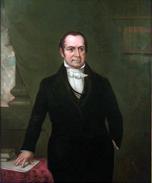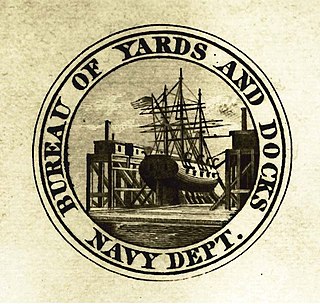
The Admiralty was a department of the Government of the United Kingdom responsible for the command of the Royal Navy until 1964, historically under its titular head, the Lord High Admiral – one of the Great Officers of State. For much of its history, from the early 18th century until its abolition, the role of the Lord High Admiral was almost invariably put "in commission" and exercised by the Lords Commissioner of the Admiralty, who sat on the governing Board of Admiralty, rather than by a single person. The Admiralty was replaced by the Admiralty Board in 1964, as part of the reforms that created the Ministry of Defence and its Navy Department.

Isaac Chauncey was an American naval officer in the United States Navy who served in the Quasi-War, The Barbary Wars and the War of 1812. In the latter part of his naval career he was President of the Board of Navy Commissioners.

Walter Forward was an American lawyer and politician. He was the brother of Chauncey Forward and Oliver Forward.

Louis Malesherbes Goldsborough was a rear admiral in the United States Navy during the American Civil War. He held several sea commands during the Civil War, including that of the North Atlantic Blockading Squadron. He was also noted for contributions to nautical scientific research.

Lewis Warrington was an officer in the United States Navy during the Barbary Wars and the War of 1812. He later became a Captain. He temporarily served as the Secretary of the Navy. His highest rank was commodore.

USS Peacock was a sloop-of-war in the United States Navy during the War of 1812.
The U.S. Navy's Bureau of Navigation was established in 1862 as part of the reorganization of the Navy Department. Principal responsibilities were to provide nautical charts and instruments and to oversee several activities involved navigation research, including the Naval Observatory. In 1889, the Bureau gained responsibilities for personnel management, and this eventually became its primary function. In 1942, the Bureau was renamed the Bureau of Naval Personnel (BuPers), under which name it continues today.
The "bureau system" of the United States Navy was the Department of the Navy's material-support organization from 1842 through 1966. The bureau chiefs were largely autonomous, reporting directly to the Secretary of the Navy and managing their respective organizations without the influence of other bureaus. In 1966, the bureaus were gradually replaced by unified commands reporting to the Chief of Naval Operations.
The New-York Mirror was a weekly newspaper published in New York City from 1823 to 1842, succeeded by The New Mirror in 1843 and 1844. Its producers then launched a daily newspaper named The Evening Mirror, which published from 1844 to 1898.

The Board of Admiralty (1628–1964) was established in 1628 when Charles I put the office of Lord High Admiral into commission. As that position was not always occupied, the purpose was to enable management of the day-to-day operational requirements of the Royal Navy; at that point administrative control of the navy was still the responsibility of the Navy Board, established in 1546. This system remained in place until 1832, when the Board of Admiralty became the sole authority charged with both administrative and operational control of the navy when the Navy Board was abolished. The term Admiralty has become synonymous with the command and control of the Royal Navy, partly personified in the Board of Admiralty and in the Admiralty buildings in London from where operations were in large part directed. It existed until 1964 when the office of First Lord of the Admiralty was finally abolished and the functions of the Lords Commissioners were transferred to the new Admiralty Board and the tri-service Defence Council of the United Kingdom.

The Kingston Royal Naval Dockyard was a Royal Navy Dockyard from 1788 to 1853 in Kingston, Ontario, Canada, at the site of the current Royal Military College of Canada.

The Bureau of Yards and Docks was the branch of the United States Navy responsible from 1842 to 1966 for building and maintaining navy yards, drydocks, and other facilities relating to ship construction, maintenance, and repair.
John B. Nicolson was an officer in the United States Navy during the first half of the 19th century.
The Columbian Institute for the Promotion of Arts and Sciences (1816–1838) was a literary and science institution in Washington, D.C., founded by Dr. Edward Cutbush (1772–1843), a naval surgeon. Thomas Law had earlier suggested of such a society "at the seat of government." It was the first "learned society" established in Washington and was organized on June 28, 1816, sixteen years after the city was occupied, and less than two years after the invasion by the British troops. The second article of its constitution states: "The Institute shall consist of mathematical, physical, moral and political sciences, general literature and fine arts."

The Civil Lord of the Admiralty formally known as the Office of the Civil Lord of Admiralty also referred to as the Department of the Civil Lord of the Admiralty was a member of the Board of Admiralty who was responsible for managing the Royal Navy's supporting civilian staff, the works and buildings departments and naval lands from 1830 to 1964.

The Surveyor of Buildings also known as the Department of the Surveyor of Buildings was the civil officer initially a member of the Navy Board then later the Board of Admiralty responsible for superintending, maintaining and improving the British Royal Navy Dockyards, Naval Buildings, and Architectural Works of the Admiralty from 1812 to 1837.
George Marshall was a chemist, pyrotechnist, artillery specialist, author, educator, and gunner in the United States Navy. He fought in the War of 1812, he was part of Commodore Isaac Chauncey's freshwater fleet on Lake Ontario. He served in the United States Navy with distinction for over forty-six years. He achieved the status of master gunner. He was one of the most important naval gunners in U.S. history. He helped build the framework of U.S. naval gunnery education. He was a 19th-century American scientist.









